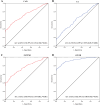Association between soluble suppression of tumorigenicity 2 and risk and severity of coronary artery disease: a case control study
- PMID: 40295953
- PMCID: PMC12038991
- DOI: 10.1186/s12872-025-04787-5
Association between soluble suppression of tumorigenicity 2 and risk and severity of coronary artery disease: a case control study
Abstract
Background: To investigate the differential expression of soluble suppression of tumorigenicity 2 (sST2) in patients with coronary artery disease (CAD) and healthy controls, and the correlation between sST2 and the severity of coronary artery atherosclerosis.
Methods: A total of 911 CAD patients were selected as the CAD group, and 322 healthy people were selected as the control group. We measured serum sST2 level by chemiluminescence immunoassay, and applied the Gensini scoring system to quantify the severity of coronary artery atherosclerosis. We utilized Mann-Whitney U test to assess the difference of sST2 level between the two groups, and adopted Spearman correlation test to evaluate the correlation between sST2 level and Gensini score and inflammatory indexes.
Results: Compared with the control group, the expression level of sST2 in CAD group was significantly increased [29.20 (20.67, 46.34) vs. 19.69 (15.97, 25.02), P < 0.001]. Logistic regression showed that sST2 expression could increase CAD risk (OR = 1.099, 95%CI: 1.080 ~ 1.119, P < 0.001). Analysis of variance revealed that the sST2 expression level increased gradually in unstable angina pectoris group (UA), non-ST elevation myocardial infarction group (NSTEMI) and ST elevation myocardial infarction group (STEMI) [UA: 23.05 (17.54, 30.75), NSTEMI: 30.71 (21.31, 42.97), STEMI: 51.05 (32.85, 80.04), P < 0.001]. Spearman correlation analysis demonstrated significantly positive associations between sST2 expression level and Gensini score (r = 0.137, P < 0.001), and systemic inflammatory indexes MHR (r = 0.188, P < 0.001), NLR (r = 0.469, P < 0.001), PLR (r = 0.285, P < 0.001) and MLR (r = 0.368, P < 0.001), but negatively correlated with AFR (r=-0.135, P < 0.001). By receiver operating characteristic (ROC) curve analysis, the sST2 expression level had excellent predictive effect in STEMI with the area under the curve (AUC) value of 0.926 (95%CI: 0.903-0.948, P < 0.001) and sensitivity and specificity of 72.3% and 99.7% respectively, superior to NSTEMI with an AUC of 0.760 (95%CI: 0.719-0.802, P < 0.001) and UA with an AUC of 0.616 (95%CI: 0.576-0.656, P < 0.001).
Conclusions: sST2 could not only serve as a biomarker for the clinical auxiliary diagnosis of CAD, but also act as a potential indicator for disease progression or risk stratification. Dynamic monitoring of sST2 levels might assist in evaluating treatment efficacy.
Keywords: Coronary artery disease; Inflammatory index; Soluble suppression of tumorigenicity 2; sST2.
© 2025. The Author(s).
Conflict of interest statement
Declarations. Ethics approval and consent to participate: This study was approved by the Medical Ethics Committee of the Affiliated Hospital of Xuzhou Medical University and conformed to guidelines of the Declaration of Helsinki. All study participants provided written informed consent. Consent for publication: Not applicable. Competing interests: The authors declare no competing interests. Clinical trial number: Not applicable.
Figures




Similar articles
-
Correlation of plasma soluble suppression of tumorigenicity-2 level with the severity and stability of coronary atherosclerosis.Coron Artery Dis. 2020 Nov;31(7):628-635. doi: 10.1097/MCA.0000000000000851. Coron Artery Dis. 2020. PMID: 32040025
-
Prognostic value of soluble suppression of tumorigenesis-2 (sST2) for cardiovascular events in coronary artery disease patients with and without diabetes mellitus.Cardiovasc Diabetol. 2021 Feb 19;20(1):49. doi: 10.1186/s12933-021-01244-3. Cardiovasc Diabetol. 2021. PMID: 33608010 Free PMC article.
-
Serum sST2, IL-33, and Hcy Expression in Older Adults Patients with Myocardial Infarction and Their Predictive Value for MACE.Clin Interv Aging. 2025 Apr 25;20:495-504. doi: 10.2147/CIA.S519437. eCollection 2025. Clin Interv Aging. 2025. PMID: 40303845 Free PMC article.
-
API expert consensus document on management of ischemic heart disease.J Assoc Physicians India. 2006 Jun;54:469-80. J Assoc Physicians India. 2006. PMID: 16909697 Review.
-
Association of sST2 with cardiovascular disease in maintenance hemodialysis patients: A systematic review and meta-analysis.J Int Med Res. 2025 Jun;53(6):3000605251345954. doi: 10.1177/03000605251345954. Epub 2025 Jun 6. J Int Med Res. 2025. PMID: 40478183 Free PMC article.
References
-
- Martin SS, Aday AW, Allen NB, Almarzooq ZI, Anderson CAM, Arora P, et al. 2025 heart disease and stroke statistics: A report of US and global data from the American heart association. Circulation. 2025;151(8):e41–660. - PubMed
-
- Center For Cardiovascular Diseases The Writing Committee Of The Report On, Cardiovascular H. Diseases in China N. Report on cardiovascular health and diseases in China 2023: an updated summary. Biomed Environ Sci. 2024;37(9):949–92. - PubMed
-
- McGill HC Jr., McMahan CA, Gidding SS. Preventing heart disease in the 21st century: implications of the Pathobiological determinants of atherosclerosis in youth (PDAY) study. Circulation. 2008;117(9):1216–27. - PubMed
-
- López-Candales A, Sawalha K. Improving diagnostic assessments in the ever-changing landscape of atherosclerosis. J Cardiovasc Med (Hagerstown). 2023;24(4):221–9. - PubMed
MeSH terms
Substances
Grants and funding
LinkOut - more resources
Full Text Sources
Medical
Miscellaneous

